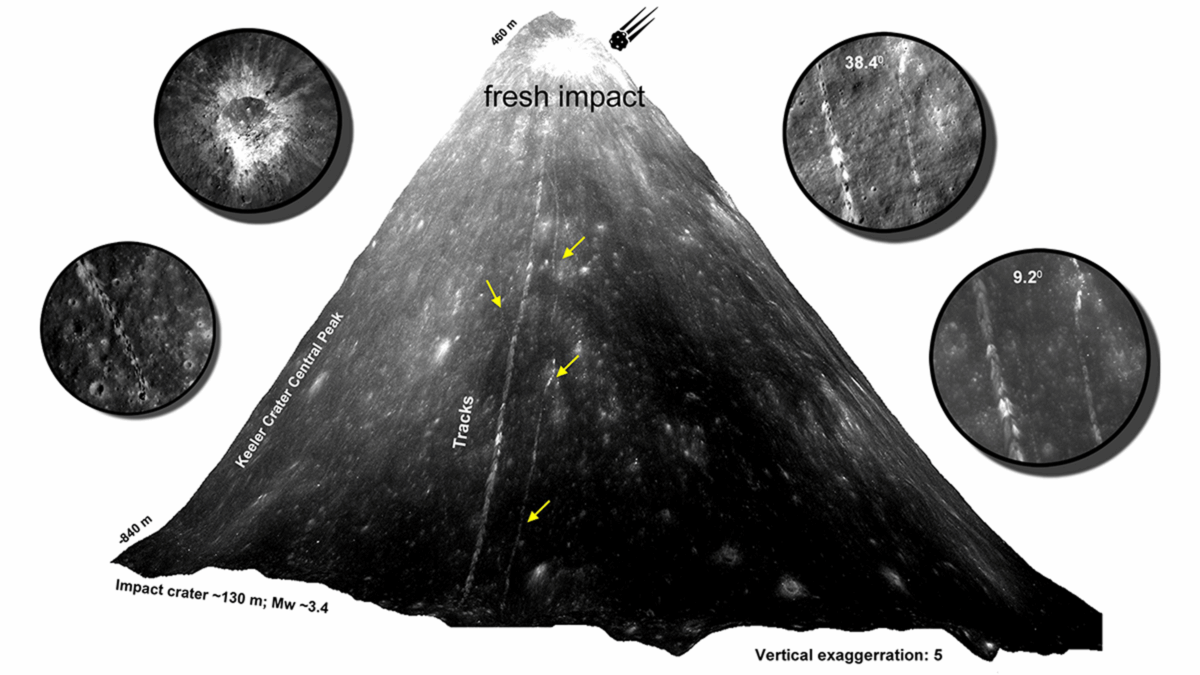As a boulder rolls down a cliff slope on the Moon, it kicks up lunar dust, leaving behind a telltale herringbone pattern of ejecta.
In a recent study, for the first time, scientists geolocated and dated evidence of such boulder falls. They identified 245 fresh tracks created as boulders rolled, bounced, and slid down crater walls.
“For a long time, there was this belief that the Moon is geologically dead.…Our study shows that boulders with sizes ranging [from] tens to hundreds of meters and [with] weights in tons have moved from their places over time,” said Sivaprahasam Vijayan, the study’s lead author and an associate professor at the Physical Research Laboratory in Ahmedabad, India. “It is equally important to know how recent these boulder fall events are to understand the time periods when the geological agents were active.”
Tracking Boulder Falls
As lunar boulders bounce, they scoop up bright, unweathered subsurface material and bring it to the surface. As a result, fresh boulder fall tracks appear brighter than older ones.
“One can identify a boulder fall to be a recent one considering the boulder fall ejecta,” said Senthil Kumar Perumal, principal scientist with the Planetary Sciences Group at the National Geophysical Research Institute in Hyderabad, India, who was not involved in the new study.
The craters were found to be around 400,000 years old—which means the BFE tracks are more recent.
To identify relatively recent boulder tracks, Vijayan and his colleagues first manually searched thousands of images of the lunar surface between 40°S and 40°N. At these latitudes, the Sun makes the bright boulder tracks distinguishable from the rest of the lunar surface. Once they identified a track, the researchers studied corresponding images taken by NASA’s Lunar Reconnaissance Orbiter Narrow Angle Camera between 2009 and 2022.
Next, scientists estimated the age of the tracks by studying regions with both boulder fall ejecta (BFE) and distinct impact ejecta blankets. (Such blankets, nicknamed the “lunar equivalent of fossils,” have long been used to estimate the age of impact events.) The craters analyzed by Vijayan and his colleagues were found to be around 400,000 years old—which means the BFE tracks are more recent.
Finally, the scientists identified possible seismic faults or impact craters nearby that could have triggered the boulder falls.
Mapping the Moon
The new geological map of boulder falls, published in Icarus, highlights seismically active spots and fresh impact sites on the Moon. Researchers say these regions could be potential landing sites for future lunar missions focused on recent surface and subsurface activity.
The study authors plan to integrate artificial intelligence methods into the next iteration of their work, but ultimately, Vijayan said, “the next step is to more precisely determine whether the cause [of a fall] is endogenic or exogenic, which can be achieved by deploying additional seismometers in upcoming missions.”
Kumar concurred. “We need to have a large network of seismometers covering the entire [Moon] that monitors seismic activity continuously for several decades,” he said.
—Unnati Ashar, Science Writer

